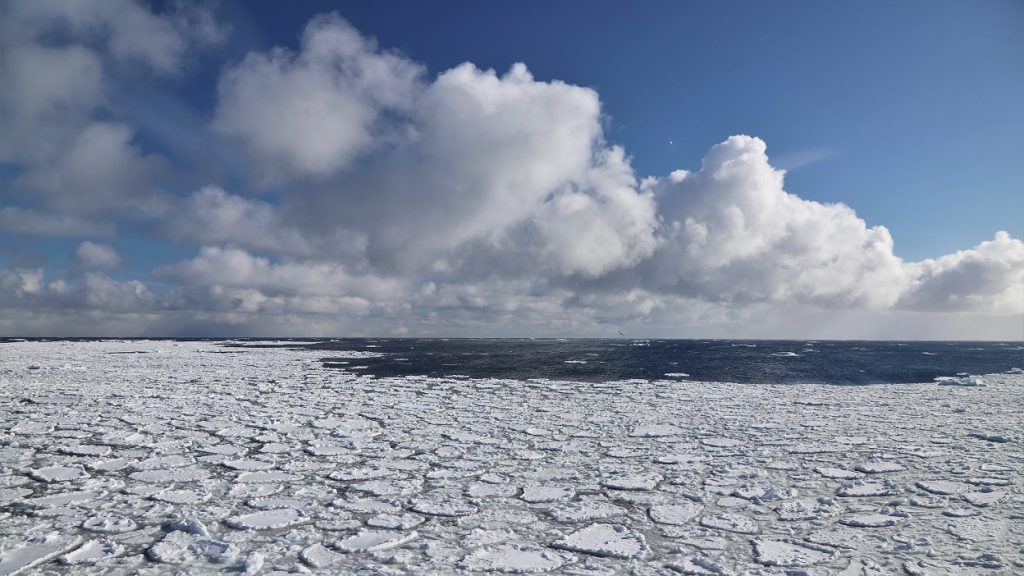
Parting the clouds
Atmospheric research by the AAPP is helping to address urgent questions about the role of Southern Ocean clouds in the Earth’s changing climate.
Clouds are one of the most important components of the global climate system but are still not entirely understood.
Depending on their properties, clouds can have a dramatic effect on the rate that the sun’s energy is transferred into the atmosphere and ocean or is reflected back into space.
Scientists have long known that clouds play a central role in the climate, but their complex and dynamic nature has made clouds stubbornly resistant to computer simulations.
Modelling the clouds over the Southern Ocean has emerged as a particular challenge, partly because of the shortage of detailed meteorological data for this remote and difficult to study region and also because of its pristine nature.
Researcher Dr Marc Mallet from the Australian Antarctic Program Partnership recently joined a multi-agency team working to address this problem.
“The Southern Ocean is one of the cloudiest places on Earth, and cloud formations there can be surprisingly complex,” said Dr Mallet.
“Southern Ocean clouds are often two or three layers deep, forming anywhere between the surface of the ocean and more than ten kilometres into the atmosphere.”
“Some clouds are made of liquid water, some are ice crystals, and others are a mix.”
“We know climate change will affect all of these properties, and we suspect it could have significant impacts on the amount of energy entering and leaving the atmosphere,” he said.
Dr Mallet and his team collating data obtained during a series of recent scientific voyages between 2015 and 2018 on the RV Investigator, RSV Aurora Australis, at Macquarie Island and from an airborne science platform owned by the US-based National Science Foundation.
“In the past, one of major challenges for climate modellers studying Southern Ocean clouds has been a lack of sophisticated long-term measurements,” said Dr Mallet.
“Satellites have an especially hard time picking up reliable information for low-level clouds, which are abundant over the Southern Ocean.”
“Low altitude clouds play a key role in trapping heat into the ocean, so understanding what the clouds are doing in the lower atmosphere is very important.”
“Efforts to collect these measurements in the Southern Ocean using ship and aeroplane-based observations have significantly ramped up in the last few years, and we now have some great data to work with.”
Australian scientists from within the AAPP across the Australian Antarctic Division, Bureau of Meteorology, CSIRO and UTAS have been instrumental in leading some of these studies and collaborating with a number of international partners and other Australian universities.
The team’s work has added relevance after the development of new global climate simulations from a project known as the Coupled Model Intercomparison Project Phase 6 (CMIP6).
The models will form part of the new Intergovernmental Panel on Climate Change (IPCC) projections of our changing climate, and show that the Earth’s temperature might be even more sensitive to rising CO2 emissions than previously thought.
“Some of these new models are indicating that Southern Ocean clouds might not be as reflective in a warmer world,” said Dr Mallet.
“There is still some disagreement between different models and there’s a lot of people trying to figure out what is happening.”
“We hope our work can shed some light on the problem, and whether alarm is warranted, and help the global research community reduce uncertainty in some of these climate projections.”
1. Zelinka, Mark D., et al. “Causes of higher climate sensitivity in CMIP6 models.” Geophysical Research Letters 47.1 (2020): e2019GL085782.
2. News article related to Zelinka et al: https://www.eenews.net/stories/1063110279“
“Now that we know this, it is potentially very important to our understanding of the rate of heat uptake, because we know that these low level clouds are more common in the Southern Ocean than elsewhere in the world.”



